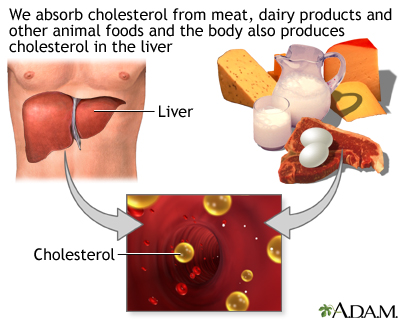| Step 1: The dangers of high cholesterol |
Cholesterol is a waxy, fat-like substance that travels throughout the body in the blood. It has many important functions and is used by all of the cells in your body. It is part of the outside layer of cell membranes and helps in the production of vitamin D and hormones like testosterone and estrogen.
Cholesterol comes from two sources. Our liver produces it, and we obtain some cholesterol in our diet from foods like meat and dairy products.

High cholesterol
Your liver makes most of the cholesterol you need. This guide is primarily about a problem that millions of people have, which is excess cholesterol floating around in their blood. (Healthy and unhealthy cholesterol levels are defined in Step 5, Cholesterol Testing.)
There are steps you can take to keep your cholesterol under control. Starting at about age 20, all adults should get a blood test on a regular basis to see if their cholesterol levels are in good shape.
When there is too much cholesterol in the blood, the excess can build up on the inner walls of arteries throughout the body, forming scar tissue and plaque (fatty deposits in the arteries). This build-up of plaque is referred to as atherosclerosis.
The plaque deposits harden and narrow the wall of the artery, reducing or stopping blood flow. In addition, the hard and inflexible artery may tear. The body forms a blood clot to try to repair the tear, but the clot may block blood flow too.

When blood flow is blocked because of narrowed arteries or a clot, serious tissue damage can occur. The result can be a heart attack, stroke, or other cardiovascular problem.
 |
To continue to the next step of the cholesterol guide, click "next" below.
|
Review Date:
12/31/2012 Reviewed By: Glenn Gandelman, MD, MPH, FACC Assistant Clinical Professor of Medicine at New York Medical College; Private Practice specializing in Cardiovascular Disease in Greenwich, CT. Review provided by VeriMed Healthcare Network. |
